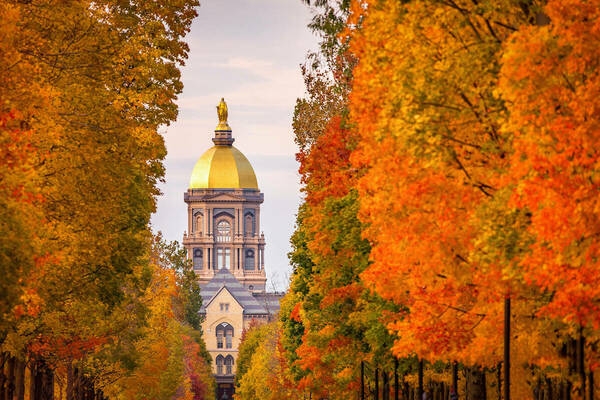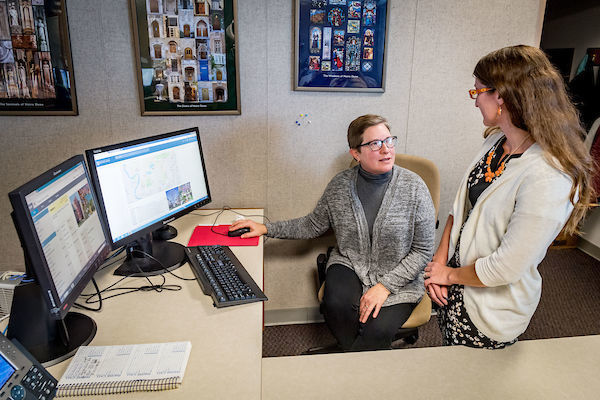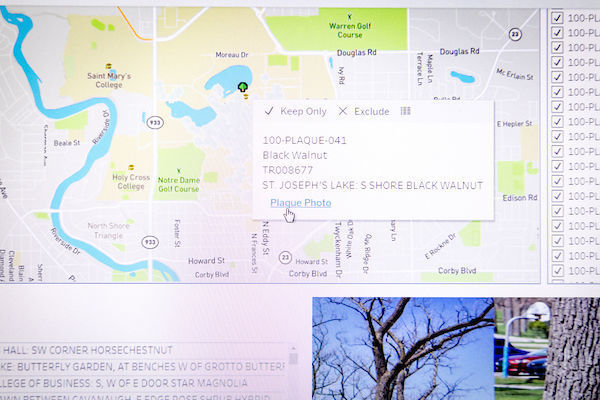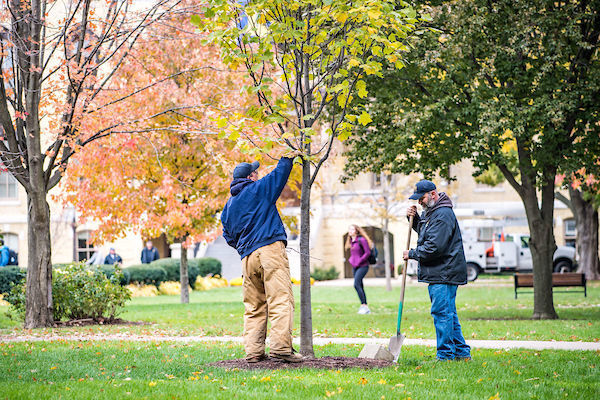
Fall is one of the most the most beautiful seasons on the Notre Dame campus. The orange, red and yellow canopy is a magnificent complement to the glow of the Golden Dome. Ever wonder what types of trees present this autumnal show? Largely, they are maples. To be exact, there are 621 sugar maples and 517 red maples, says Barbara Hellenthal, curator of the Museum of Biodiversity and the Greene-Nieuwland Herbarium. Both species are native to the region and colorful.
When the University’s founder Rev. Edward Sorin, C.S.C. first laid eyes on the 524 acres bequeathed to the Congregation of Holy Cross to build a Catholic university, he would have seen the ash trees, oaks, hickories and maples that surround St. Mary’s and St. Joseph’s lakes. But he also knew what new trees could do for the landscape. It was his vision to have the double-maple-lined paths leading from Notre Dame Avenue to the Main Building.
All these years later, the trees remain integral to the beauty of campus — so much so that a couple of biologists were inspired to conduct a census of plantings to commemorate, in 2017, the 175th anniversary of the University’s founding.
It would be the second time that Hellenthal, associate professional speciallist in the Department of Biological Sciences, and husband Ron Hellenthal, professor emeritus, would conduct such research. In 1993, to celebrate the University’s sesquicentennial, their work was published in the book “Trees, Shrubs and Vines on the University of Notre Dame Campus.” Ron managed the data and Barbara was a co-author.
About two years before the 175th, campus leaders caught wind of the Hellenthals’ project and considered how it could be expanded to also catalog the condition of each planting as well as the locations of donor memorial tree plaques, among other things.
A gift to Landscape Services from Tom and Lucy Korth for campus beautification got things started by covering the cost for the undergraduate researchers who worked with Barbara and Ron. The expanded project would make data work harder for the University and is a shining example of synergism between academic and administrative offices.
“Notre Dame is among the first universities to develop a project of this magnitude. It’s one of the most comprehensive surveys of trees and plants on any campus,” Ron proudly notes.
 Jessica Woolley and Dana Schraeder
Jessica Woolley and Dana Schraeder
A tree census expands
Jessica Woolley, who managed the Work Control Center, where all campus maintenance requests are submitted, is among those who provided vision for the project. She saw the opportunity to utilize the data visualization and analysis tools of the University’s dataND program to make the tree survey information accessible to the campus community.
This would enable Landscape Services to electronically track and assess the condition of trees from one corner of campus to the other. Development would be able to pinpoint locations of benefactor trees and the corresponding memorial plaques. Facilities Design and Operations could use the visual tool to reference trees while managing the planning, design and construction of buildings. Meanwhile, the Office of Sustainability would use it to maintain a healthy green footprint on campus.

“Proper care of the University’s trees not only enhances the experience of students, alumni and visitors, but it also helps in our efforts to keep our campus green in every way,” says Carol Mullaney, senior director of the Office of Sustainability and Continuous Improvement.
The timing was perfect. The Office of Information Technologies (OIT) had begun to centralize data storage across campus through dataND to allow for better analysis of information for key decision-making. While dataND focuses on four core areas— faculty, staff, students and space (e.g., buildings, land) — the campus tree project aligned directly with the mission of dataND.
Dana Schrader, an OIT business intelligence analyst, partnered with Woolley on this part of the project.
 AiM System at the Work Control Center
AiM System at the Work Control Center
Putting that tree data to work
After the Hellenthals and the students recorded each tree, plant and vine, they entered all the information into a database. With the help of OIT’s Campus Admin Solutions, the Work Control Center then manipulated the data into the format and fields used in AiM, the University’s work-order system. Tableau software turned it into information that users across campus, with varying interests and needs, could retrieve.
Utilizing Tableau’s mapping capabilities and the GPS coordinates collected from the tree study, a campus map was created displaying the tree location and tree details such as its species, measurements and overall health. The next step was to transform the map into the interactive, informative dashboard that shows users the abundance of campus’ natural beauty in its trees and shrubs.
 Landscape Services staff care for a tree on Main Quad
Landscape Services staff care for a tree on Main Quad
In 2018, Pat McCauslin, then-superintendent of Landscape Services, called the tree inventory database invaluable. “It will aid our staff arborists and tree crews to protect and preserve the diversity of tree species on campus. Many of the trees were planted years ago by Holy Cross priests and brothers. Our team is dedicated to ensuring they remain healthy and vibrant for years to come.”
(This story was originally published in June 2018 and was updated in June 2019 to reflect retirements of two individuals mentioned here.)
Originally published by at ndworks.nd.edu on October 07, 2019.